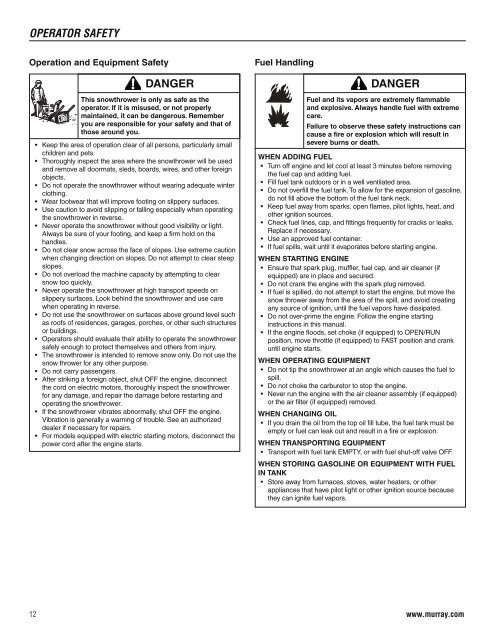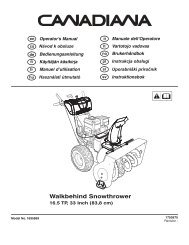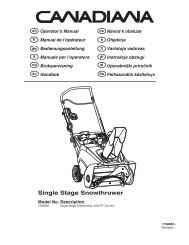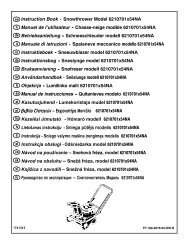Walkbehind Snowthrower
Walkbehind Snowthrower
Walkbehind Snowthrower
- No tags were found...
You also want an ePaper? Increase the reach of your titles
YUMPU automatically turns print PDFs into web optimized ePapers that Google loves.
OPERATOR SAFETY<br />
Operation and Equipment Safety<br />
Fuel Handling<br />
DANGER<br />
This snowthrower is only as safe as the<br />
operator. If it is misused, or not properly<br />
maintained, it can be dangerous. Remember<br />
you are responsible for your safety and that of<br />
those around you.<br />
• Keep the area of operation clear of all persons, particularly small<br />
children and pets.<br />
• Thoroughly inspect the area where the snowthrower will be used<br />
and remove all doormats, sleds, boards, wires, and other foreign<br />
objects.<br />
• Do not operate the snowthrower without wearing adequate winter<br />
clothing.<br />
• Wear footwear that will improve footing on slippery surfaces.<br />
• Use caution to avoid slipping or falling especially when operating<br />
the snowthrower in reverse.<br />
• Never operate the snowthrower without good visibility or light.<br />
Always be sure of your footing, and keep a firm hold on the<br />
handles.<br />
• Do not clear snow across the face of slopes. Use extreme caution<br />
when changing direction on slopes. Do not attempt to clear steep<br />
slopes.<br />
• Do not overload the machine capacity by attempting to clear<br />
snow too quickly.<br />
• Never operate the snowthrower at high transport speeds on<br />
slippery surfaces. Look behind the snowthrower and use care<br />
when operating in reverse.<br />
• Do not use the snowthrower on surfaces above ground level such<br />
as roofs of residences, garages, porches, or other such structures<br />
or buildings.<br />
• Operators should evaluate their ability to operate the snowthrower<br />
safely enough to protect themselves and others from injury.<br />
• The snowthrower is intended to remove snow only. Do not use the<br />
snow thrower for any other purpose.<br />
• Do not carry passengers.<br />
• After striking a foreign object, shut OFF the engine, disconnect<br />
the cord on electric motors, thoroughly inspect the snowthrower<br />
for any damage, and repair the damage before restarting and<br />
operating the snowthrower.<br />
• If the snowthrower vibrates abnormally, shut OFF the engine.<br />
Vibration is generally a warning of trouble. See an authorized<br />
dealer if necessary for repairs.<br />
• For models equipped with electric starting motors, disconnect the<br />
power cord after the engine starts.<br />
DANGER<br />
Fuel and its vapors are extremely flammable<br />
and explosive. Always handle fuel with extreme<br />
care.<br />
Failure to observe these safety instructions can<br />
cause a fire or explosion which will result in<br />
severe burns or death.<br />
WHEN ADDING FUEL<br />
• Turn off engine and let cool at least 3 minutes before removing<br />
the fuel cap and adding fuel.<br />
• Fill fuel tank outdoors or in a well ventilated area.<br />
• Do not overfill the fuel tank. To allow for the expansion of gasoline,<br />
do not fill above the bottom of the fuel tank neck.<br />
• Keep fuel away from sparks, open flames, pilot lights, heat, and<br />
other ignition sources.<br />
• Check fuel lines, cap, and fittings frequently for cracks or leaks.<br />
Replace if necessary.<br />
• Use an approved fuel container.<br />
• If fuel spills, wait until it evaporates before starting engine.<br />
WHEN STARTING ENGINE<br />
• Ensure that spark plug, muffler, fuel cap, and air cleaner (if<br />
equipped) are in place and secured.<br />
• Do not crank the engine with the spark plug removed.<br />
• If fuel is spilled, do not attempt to start the engine, but move the<br />
snow thrower away from the area of the spill, and avoid creating<br />
any source of ignition, until the fuel vapors have dissipated.<br />
• Do not over-prime the engine. Follow the engine starting<br />
instructions in this manual.<br />
• If the engine floods, set choke (if equipped) to OPEN/RUN<br />
position, move throttle (if equipped) to FAST position and crank<br />
until engine starts.<br />
WHEN OPERATING EQUIPMENT<br />
• Do not tip the snowthrower at an angle which causes the fuel to<br />
spill.<br />
• Do not choke the carburetor to stop the engine.<br />
• Never run the engine with the air cleaner assembly (if equipped)<br />
or the air filter (if equipped) removed.<br />
WHEN CHANGING OIL<br />
• If you drain the oil from the top oil fill tube, the fuel tank must be<br />
empty or fuel can leak out and result in a fire or explosion.<br />
WHEN TRANSPORTING EQUIPMENT<br />
• Transport with fuel tank EMPTY, or with fuel shut-off valve OFF.<br />
WHEN STORING GASOLINE OR EQUIPMENT WITH FUEL<br />
IN TANK<br />
• Store away from furnaces, stoves, water heaters, or other<br />
appliances that have pilot light or other ignition source because<br />
they can ignite fuel vapors.<br />
12<br />
www.murray.com








